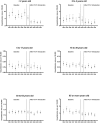Changing epidemiology of pneumococcal meningitis after the introduction of pneumococcal conjugate vaccine in the United States
- PMID: 18433334
- PMCID: PMC4822508
- DOI: 10.1086/587897
Changing epidemiology of pneumococcal meningitis after the introduction of pneumococcal conjugate vaccine in the United States
Abstract
Background: Although hospitalizations due to invasive pneumococcal disease decreased after routine vaccination of young children with a 7-valent pneumococcal conjugate vaccine (PCV7) began in 2000, information on the trends in pneumococcal meningitis is limited.
Methods: We estimated national trends in rates of hospitalization for pneumococcal meningitis, using data from the Nationwide Inpatient Sample, 1994-2004. Pneumococcal meningitis cases and deaths were identified on the basis of the International Classification of Diseases, Ninth Edition, Clinical Modification coded primary discharge diagnosis, and rates were calculated using US Census data as denominators. The year 2000 was considered to be a transition year, and the average annualized rate after PCV7 introduction (2001-2004) was compared with that during the baseline years (1994-1999).
Results: During 1994-2004, there were 21,396 hospitalizations and 2684 deaths (12.5%) due to pneumococcal meningitis in the United States. In children aged < 2 years, the average annualized rates of pneumococcal meningitis hospitalizations per 100,000 population decreased from 7.7 in 1994-1999 to 2.6 in 2001-2004 (change, -66.0%; 95% confidence interval [CI], -73.5% to -56.3%). Among children aged 2-4 years, the hospitalization rate decreased from 0.9 to 0.5 per 100,000 (change, -51.5%; 95% CI, -66.9% to -28.9%). Average rates also decreased by 33.0% (95% CI, -43.4% to -20.9%) among adults aged > or = 65 years. After PCV7 introduction (2001-2004), an estimated 1822 and 573 pneumococcal meningitis hospitalizations were prevented in persons aged < 5 years and > or = 65 years, respectively. Overall, an estimated 3330 pneumococcal meningitis hospitalizations and 394 deaths were prevented in persons of all ages during 2001-2004 in the United States.
Conclusion: After implementation of routine childhood vaccination with PCV7, hospitalizations for pneumococcal meningitis decreased significantly for both children and adults. Most pneumococcal meningitis cases now occur among adults.
Conflict of interest statement
Figures




Comment in
-
Use of pneumococcal conjugate vaccine to decrease rates of bacterial meningitis.Clin Infect Dis. 2008 Jun 1;46(11):1673-6. doi: 10.1086/587898. Clin Infect Dis. 2008. PMID: 18433336 No abstract available.
Similar articles
-
Trends in pneumococcal meningitis hospitalizations following the introduction of the 13-valent pneumococcal conjugate vaccine in the United States.Vaccine. 2017 Oct 27;35(45):6160-6165. doi: 10.1016/j.vaccine.2017.09.050. Epub 2017 Sep 23. Vaccine. 2017. PMID: 28951086
-
Effect of pneumococcal conjugate vaccine on pneumococcal meningitis.N Engl J Med. 2009 Jan 15;360(3):244-56. doi: 10.1056/NEJMoa0800836. N Engl J Med. 2009. PMID: 19144940 Free PMC article.
-
Pneumococcal meningitis and vaccine effects in the era of conjugate vaccination: results of 20 years of nationwide surveillance in Germany.BMC Infect Dis. 2015 Feb 14;15:61. doi: 10.1186/s12879-015-0787-1. BMC Infect Dis. 2015. PMID: 25885764 Free PMC article.
-
The multifaceted impact of pneumococcal conjugate vaccine implementation in children in France between 2001 to 2014.Hum Vaccin Immunother. 2016;12(2):277-84. doi: 10.1080/21645515.2015.1116654. Hum Vaccin Immunother. 2016. PMID: 26905678 Free PMC article. Review.
-
The impact of 7-valent pneumococcal conjugate vaccine on invasive pneumococcal disease: a literature review.Adv Ther. 2013 Feb;30(2):127-51. doi: 10.1007/s12325-013-0007-6. Epub 2013 Feb 7. Adv Ther. 2013. PMID: 23397399 Review.
Cited by
-
A hospital-based study on etiology and prognosis of bacterial meningitis in adults.Sci Rep. 2021 Mar 16;11(1):6028. doi: 10.1038/s41598-021-85382-4. Sci Rep. 2021. PMID: 33727651 Free PMC article.
-
Pediatric invasive pneumococcal disease in the United States in the era of pneumococcal conjugate vaccines.Clin Microbiol Rev. 2012 Jul;25(3):409-19. doi: 10.1128/CMR.00018-12. Clin Microbiol Rev. 2012. PMID: 22763632 Free PMC article. Review.
-
Dengue vaccine trial guidelines and role of large-scale, post proof-of-concept demonstration projects in bringing a dengue vaccine to use in dengue endemic areas.Hum Vaccin. 2010 Oct;6(10):802-9. doi: 10.4161/hv.6.10.13018. Epub 2010 Oct 1. Hum Vaccin. 2010. PMID: 20935506 Free PMC article. Review.
-
Emergence of parapneumonic empyema in the USA.Thorax. 2011 Aug;66(8):663-8. doi: 10.1136/thx.2010.156406. Epub 2011 May 26. Thorax. 2011. PMID: 21617169 Free PMC article.
-
Mechanisms of microbial traversal of the blood-brain barrier.Nat Rev Microbiol. 2008 Aug;6(8):625-34. doi: 10.1038/nrmicro1952. Epub 2008 Jul 7. Nat Rev Microbiol. 2008. PMID: 18604221 Free PMC article. Review.
References
-
- Schuchat A, Robinson K, Wenger JD, et al. Bacterial meningitis in the United States in 1995. Active Surveillance Team. New England Journal of Medicine. 1997 Oct 2;337(14):970–6. - PubMed
-
- Robinson KA, Baughman W, Rothrock G, et al. Epidemiology of invasive Streptococcus pneumoniae infections in the United States, 1995-1998: Opportunities for prevention in the conjugate vaccine era. JAMA. 2001;285(13):1729–35. - PubMed
-
- Preventing pneumococcal disease among infants and young children. Recommendations of the Advisory Committee on Immunization Practices (ACIP) MMWR RecommRep. 2000;49(RR-9):1–35. - PubMed
-
- Weisfelt M, van de Beek D, Spanjaard L, Reitsma JB, de Gans J. Clinical features, complications, and outcome in adults with pneumococcal meningitis: a prospective case series. Lancet Neurology. 2006;5(2):123–9. - PubMed
-
- Haddy RI, Perry K, Chacko CE, et al. Comparison of incidence of invasive Streptococcus pneumoniae disease among children before and after introduction of conjugated pneumococcal vaccine. Pediatr Infect Dis J. 2005 Apr;24(4):320–3. - PubMed

